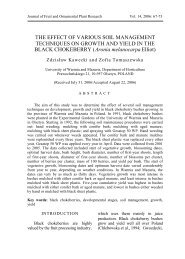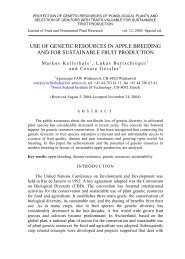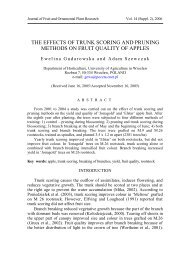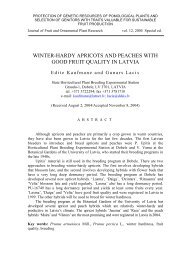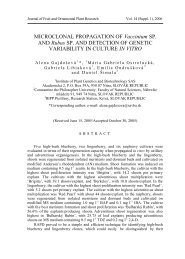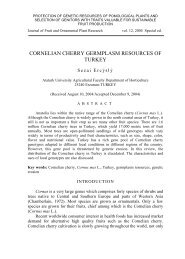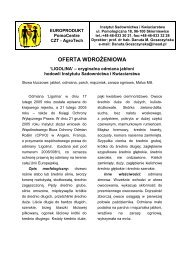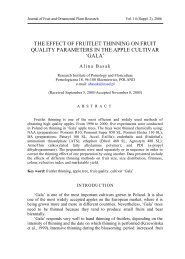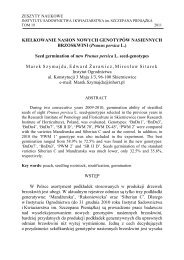seed count, fruit quality and storage properties in four apple cultivars
seed count, fruit quality and storage properties in four apple cultivars
seed count, fruit quality and storage properties in four apple cultivars
You also want an ePaper? Increase the reach of your titles
YUMPU automatically turns print PDFs into web optimized ePapers that Google loves.
Count, <strong>fruit</strong> <strong>quality</strong> <strong>and</strong> <strong>storage</strong> <strong>properties</strong> <strong>in</strong>…<strong>apple</strong>…<br />
No correlation was found between <strong>seed</strong> <strong>count</strong> <strong>and</strong> ribb<strong>in</strong>33g or malformation,<br />
probably because the <strong>apple</strong>s <strong>in</strong> this study were generally well poll<strong>in</strong>ated <strong>and</strong> <strong>seed</strong><br />
<strong>count</strong> was probably above the critical level connected with these problems.<br />
Seed <strong>count</strong> was also not correlated with sk<strong>in</strong> wax<strong>in</strong>ess <strong>and</strong> blush<strong>in</strong>g (data<br />
not presented).<br />
There was a correlation between <strong>seed</strong> <strong>count</strong> <strong>and</strong> calyx open<strong>in</strong>g only <strong>in</strong><br />
‘Nabella’. Fruits with higher <strong>seed</strong> <strong>count</strong>s more often had closed calyces.<br />
In ‘Nabella’, <strong>fruit</strong>s with a higher <strong>seed</strong> <strong>count</strong> had higher vitam<strong>in</strong> C content.<br />
Except for this, though, high <strong>seed</strong> <strong>count</strong> was generally negatively correlated with<br />
almost all <strong>fruit</strong> <strong>quality</strong> parameters. These conflicts with some studies <strong>in</strong> the<br />
literature which report that <strong>seed</strong> <strong>count</strong> is positively correlated with acidity <strong>and</strong><br />
firmness. The discrepancy may be due to the fact that the <strong>apple</strong>s were evaluated at<br />
different stages of maturity.<br />
Seed <strong>count</strong> was correlated with calcium content <strong>in</strong> only one s<strong>in</strong>gle case <strong>in</strong> this<br />
study. This conflicts with other studies <strong>in</strong> the literature. In fact, one year, there<br />
was a markedly negative correlation between <strong>seed</strong> <strong>count</strong> <strong>and</strong> calcium content <strong>in</strong><br />
‘Resista’. However, it should be kept <strong>in</strong> m<strong>in</strong>d that calcium content <strong>in</strong> <strong>apple</strong>s is<br />
also negatively correlated with <strong>fruit</strong> size (Broom et al., 1998; Tomala, 1999).<br />
Calcium concentration has also been reported to be negatively correlated with<br />
ethylene concentration (Tomala <strong>and</strong> Dilley, 1989). ‘Resista’ is one of the <strong>apple</strong><br />
<strong>cultivars</strong> with an extremely high concentration of ethylene (Goliáš, 2005). There<br />
is probably a complex <strong>in</strong>terrelationship between all of these factors.<br />
40<br />
30<br />
%<br />
20<br />
10<br />
Rotten <strong>fruit</strong>s<br />
Breakdown<br />
Bitter pit<br />
0<br />
1-2 2-5 5-8 over 8<br />
Seed number<br />
L.S.D. P≥0.05 = 7.4, 15.0 <strong>and</strong> 9.3 for rotten <strong>fruit</strong>s, breakdown <strong>and</strong> bitter pit respectively<br />
Figure 5. Seed <strong>count</strong> versus <strong>fruit</strong> rott<strong>in</strong>g, <strong>in</strong>ternal breakdown <strong>and</strong> bitter pit <strong>in</strong><br />
‘Nabella’<br />
J. Fruit Ornam. Plant Res. vol. 14 (Suppl. 2), 2006: 151-160 157




